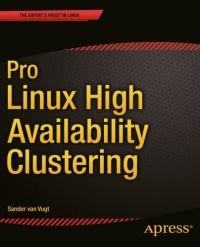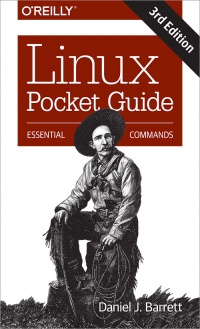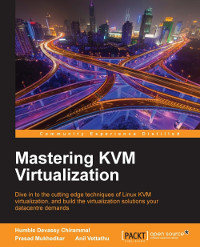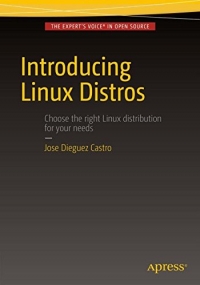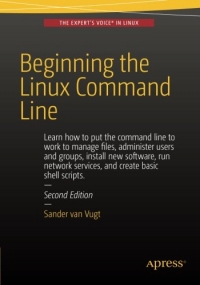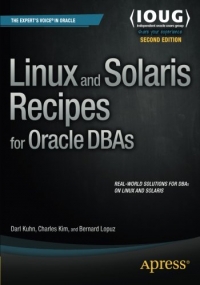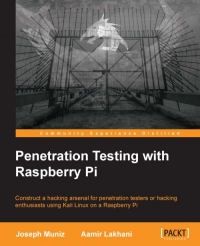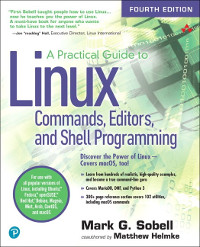Pro Linux High Availability Clustering
Pro Linux High Availability Clustering teaches you how to implement this fundamental Linux add-on into your business. Linux High Availability Clustering is needed to ensure the availability of mission critical resources. The technique is applied more and more in corporate datacenters around the world. While lots of documentation about the subject is available on the internet, it isn't always easy to build a real solution based on that scattered information, which is often oriented towards specific tasks only. Pro Linux High Availability Clustering explains essential high-availability clustering components on all Linux platforms, giving you the insight to build solutions for any specific case needed. ...
Pro Linux High Availability Clustering teaches you how to implement this fundamental Linux add-on into your business. Linux High Availability Clustering is needed to ensure the availability of mission critical resources. The technique is applied more and more in corporate datacenters around the world. While lots of documentation about the subject is available on the internet, it isn't always easy to build a real solution based on that scattered information, which is often oriented towards specific tasks only. Pro Linux High Availability Clustering explains essential high-availability clustering components on all Linux platforms, giving you the insight to build solutions for any specific case needed. ...
Linux Pocket Guide, 3rd Edition
If you use Linux in your day-to-day work, this popular pocket guide is the perfect on-the-job reference. The third edition features new commands for processing image files and audio files, running and killing programs, reading and modifying the system clipboard, and manipulating PDF files, as well as other commands requested by readers. You'll also find powerful command-line idioms you might not be familiar with, such as process substitution and piping into bash. Linux Pocket Guide provides an organized learning path to help you gain mastery of the most useful and important commands. Whether you're a novice who needs to get up to speed on Linux or an experienced user who wants a concise and functional reference, this guide provides quick answers. ...
If you use Linux in your day-to-day work, this popular pocket guide is the perfect on-the-job reference. The third edition features new commands for processing image files and audio files, running and killing programs, reading and modifying the system clipboard, and manipulating PDF files, as well as other commands requested by readers. You'll also find powerful command-line idioms you might not be familiar with, such as process substitution and piping into bash. Linux Pocket Guide provides an organized learning path to help you gain mastery of the most useful and important commands. Whether you're a novice who needs to get up to speed on Linux or an experienced user who wants a concise and functional reference, this guide provides quick answers. ...
Mastering KVM Virtualization
A robust datacenter is essential for any organization – but you don't want to waste resources. With KVM you can virtualize your datacenter, transforming a Linux operating system into a powerful hypervisor that allows you to manage multiple OS with minimal fuss. This book doesn't just show you how to virtualize with KVM – it shows you how to do it well. Written to make you an expert on KVM, you'll learn to manage the three essential pillars of scalability, performance and security – as well as some useful integrations with cloud services such as OpenStack. From the fundamentals of setting up a standalone KVM virtualization platform, and the best tools to harness it effectively, including virt-manager, and kimchi-project, everything you do is built around making KVM work for you in the real-world, helping you to interact and customize it as you need it. With further guidance on performance optimization for Microsoft Windows and RHEL virtual machines, as well as proven strategies ...
A robust datacenter is essential for any organization – but you don't want to waste resources. With KVM you can virtualize your datacenter, transforming a Linux operating system into a powerful hypervisor that allows you to manage multiple OS with minimal fuss. This book doesn't just show you how to virtualize with KVM – it shows you how to do it well. Written to make you an expert on KVM, you'll learn to manage the three essential pillars of scalability, performance and security – as well as some useful integrations with cloud services such as OpenStack. From the fundamentals of setting up a standalone KVM virtualization platform, and the best tools to harness it effectively, including virt-manager, and kimchi-project, everything you do is built around making KVM work for you in the real-world, helping you to interact and customize it as you need it. With further guidance on performance optimization for Microsoft Windows and RHEL virtual machines, as well as proven strategies ...
Introducing Linux Distros
The first barrier that a new Linux user has to face is the overwhelming number of "flavors" that this operating system has. These "flavors" are commonly known as distros (from distribution), and to date there are more than three hundred active distros to choose from. So, how to choose one? You can choose the most popular at the moment, or take heed of what your friend says, but are you sure that this is the one that you need? Making the wrong decision on this matter is behind a good number of disappointments with this operating system. You need to choose the distro that is right for you and your needs. Introducing Linux Distros teaches you the pros and the cons of the most frequently used distros in order to find the one that is right for you. You will explore each distro step by step, so that you don't have to endure hours of web surfing, countless downloads, becoming confused by new concepts and, in the worst cases, reading complex and marathon installation gui ...
The first barrier that a new Linux user has to face is the overwhelming number of "flavors" that this operating system has. These "flavors" are commonly known as distros (from distribution), and to date there are more than three hundred active distros to choose from. So, how to choose one? You can choose the most popular at the moment, or take heed of what your friend says, but are you sure that this is the one that you need? Making the wrong decision on this matter is behind a good number of disappointments with this operating system. You need to choose the distro that is right for you and your needs. Introducing Linux Distros teaches you the pros and the cons of the most frequently used distros in order to find the one that is right for you. You will explore each distro step by step, so that you don't have to endure hours of web surfing, countless downloads, becoming confused by new concepts and, in the worst cases, reading complex and marathon installation gui ...
Beginning the Linux Command Line, 2nd edition
This is Linux for those of us who don't mind typing. All Linux users and administrators tend to like the flexibility and speed of Linux administration from the command line in byte–sized chunks, instead of fairly standard graphical user interfaces. Beginning the Linux Command Line is verified against all of the most important Linux distributions, and follows a task–oriented approach which is distribution agnostic. Now this 2nd Edition of Beginning the Linux Command Line updates to the very latest versions of the Linux Operating System, including the new Btrfs file system and its management, and systemd boot procedure and firewall management with firewalld! ...
This is Linux for those of us who don't mind typing. All Linux users and administrators tend to like the flexibility and speed of Linux administration from the command line in byte–sized chunks, instead of fairly standard graphical user interfaces. Beginning the Linux Command Line is verified against all of the most important Linux distributions, and follows a task–oriented approach which is distribution agnostic. Now this 2nd Edition of Beginning the Linux Command Line updates to the very latest versions of the Linux Operating System, including the new Btrfs file system and its management, and systemd boot procedure and firewall management with firewalld! ...
CentOS High Availability
The high performance and stability of CentOS Linux are the key factors that make CentOS Linux the right Linux distribution to build high availability solutions on. This book introduces you to high availability before briefly walking you through the cluster stack and its layers. The book is then divided into two parts, part A and part B, based on CentOS versions 6 and 7 respectively. Each part begins with the installation and configuration of the Corosync cluster messaging software with CMAN or with the Pacemaker cluster resource management software. You will also be introduced to cluster service configuration and cluster service management before you configure fencing or STONITH on CentOS 6 and CentOS 7. By the end of this book, you will have the skills required to independently design, implement, and maintain a CentOS high availability multinode cluster environment. ...
The high performance and stability of CentOS Linux are the key factors that make CentOS Linux the right Linux distribution to build high availability solutions on. This book introduces you to high availability before briefly walking you through the cluster stack and its layers. The book is then divided into two parts, part A and part B, based on CentOS versions 6 and 7 respectively. Each part begins with the installation and configuration of the Corosync cluster messaging software with CMAN or with the Pacemaker cluster resource management software. You will also be introduced to cluster service configuration and cluster service management before you configure fencing or STONITH on CentOS 6 and CentOS 7. By the end of this book, you will have the skills required to independently design, implement, and maintain a CentOS high availability multinode cluster environment. ...
Linux and Solaris Recipes for Oracle DBAs, 2nd Edition
Linux and Solaris Recipes for Oracle DBAs, 2nd Edition is an example–based book on managing Oracle Database under Linux and Solaris. The book is written for database administrators who need to get work done and lack the luxury of curling up fireside with a stack of operating-system documentation. What this book provides instead is task-oriented coverage designed around the needs of the Oracle Database Administrator. Find the right chapter. Look up the task to perform. See the solution. Implement the solution straight away in your own environment. Get the job done. New in this edition is coverage of Oracle's own Solaris operating system. Oracle Corporation has been working diligently to bring commonality between Solaris and Linux, and this book takes advantage of those efforts to provide task-oriented solutions that work on common distributions of Linux such as Red Hat Enterprise Linux and Oracle Enterprise Linux while also accommodating the growing number of Oracle Solaris custome ...
Linux and Solaris Recipes for Oracle DBAs, 2nd Edition is an example–based book on managing Oracle Database under Linux and Solaris. The book is written for database administrators who need to get work done and lack the luxury of curling up fireside with a stack of operating-system documentation. What this book provides instead is task-oriented coverage designed around the needs of the Oracle Database Administrator. Find the right chapter. Look up the task to perform. See the solution. Implement the solution straight away in your own environment. Get the job done. New in this edition is coverage of Oracle's own Solaris operating system. Oracle Corporation has been working diligently to bring commonality between Solaris and Linux, and this book takes advantage of those efforts to provide task-oriented solutions that work on common distributions of Linux such as Red Hat Enterprise Linux and Oracle Enterprise Linux while also accommodating the growing number of Oracle Solaris custome ...
Linux Shell Scripting Essentials
Shell scripting is a quick method to prototype complex applications or problems. Shell scripts are a collection of commands to automate tasks, usually those for which the user has a repeated need, when working on Linux-based systems. Using simple commands or a combination of them in a shell can solve complex problems easily. This book starts with the basics, including essential commands that can be executed on Linux systems to perform tasks within a few nanoseconds. You'll learn to use outputs from commands and transform them to show the data you require. Discover how to write shell scripts easily, execute script files, debug, and handle errors. Next, you'll explore environment variables in shell programming and learn how to customize them and add a new environment. Finally, the book walks you through processes and how these interact with your shell scripts, along with how to use scripts to automate tasks and how to embed other languages and execute them. ...
Shell scripting is a quick method to prototype complex applications or problems. Shell scripts are a collection of commands to automate tasks, usually those for which the user has a repeated need, when working on Linux-based systems. Using simple commands or a combination of them in a shell can solve complex problems easily. This book starts with the basics, including essential commands that can be executed on Linux systems to perform tasks within a few nanoseconds. You'll learn to use outputs from commands and transform them to show the data you require. Discover how to write shell scripts easily, execute script files, debug, and handle errors. Next, you'll explore environment variables in shell programming and learn how to customize them and add a new environment. Finally, the book walks you through processes and how these interact with your shell scripts, along with how to use scripts to automate tasks and how to embed other languages and execute them. ...
Penetration Testing with Raspberry Pi
The Raspberry Pi is a low-cost credit-card sized computing system that can be customized for just about anything including penetration testing. Raspberry Pi is the best known platform not because it is cheap but because it is very powerful. Kali is a pentesting/security auditing Linux distribution. Kali Linux has many penetration-testing programs, including nmap (a port scanner), Wireshark (a packet analyzer), John the Ripper (a password cracker), Aircrack-ng (a software suite for the penetration-testing of wireless LANs), and Burp suite and OWASP ZAP (both web application security scanners). This book covers how to turn a Raspberry Pi into a hacking arsenal to leverage the most popular open source toolkit, Kali Linux. You will learn how to use various tools to breach networks and steal data. ...
The Raspberry Pi is a low-cost credit-card sized computing system that can be customized for just about anything including penetration testing. Raspberry Pi is the best known platform not because it is cheap but because it is very powerful. Kali is a pentesting/security auditing Linux distribution. Kali Linux has many penetration-testing programs, including nmap (a port scanner), Wireshark (a packet analyzer), John the Ripper (a password cracker), Aircrack-ng (a software suite for the penetration-testing of wireless LANs), and Burp suite and OWASP ZAP (both web application security scanners). This book covers how to turn a Raspberry Pi into a hacking arsenal to leverage the most popular open source toolkit, Kali Linux. You will learn how to use various tools to breach networks and steal data. ...
A Practical Guide to Linux Commands, Editors, and Shell Programming, 4th Edition
Linux is today's dominant Internet server platform. System administrators and Web developers need deep Linux fluency, including expert knowledge of shells and the command line. This is the only guide with everything you need to achieve that level of Linux mastery. Renowned Linux expert Mark Sobell has brought together comprehensive, insightful guidance on the tools sysadmins, developers, and power users need most, and has created an outstanding day-to-day reference, updated with assistance from new coauthor Matthew Helmke. This title is 100 percent distribution and release agnostic. Packed with hundreds of high-quality, realistic examples, it presents Linux from the ground up: the clearest explanations and most useful information about everything from filesystems to shells, editors to utilities, and programming tools to regular expressions. Use a Mac? You'll find coverage of the macOS command line, including macOS-only tools and utilities that other Linux/UNIX titles ignore. F ...
Linux is today's dominant Internet server platform. System administrators and Web developers need deep Linux fluency, including expert knowledge of shells and the command line. This is the only guide with everything you need to achieve that level of Linux mastery. Renowned Linux expert Mark Sobell has brought together comprehensive, insightful guidance on the tools sysadmins, developers, and power users need most, and has created an outstanding day-to-day reference, updated with assistance from new coauthor Matthew Helmke. This title is 100 percent distribution and release agnostic. Packed with hundreds of high-quality, realistic examples, it presents Linux from the ground up: the clearest explanations and most useful information about everything from filesystems to shells, editors to utilities, and programming tools to regular expressions. Use a Mac? You'll find coverage of the macOS command line, including macOS-only tools and utilities that other Linux/UNIX titles ignore. F ...
